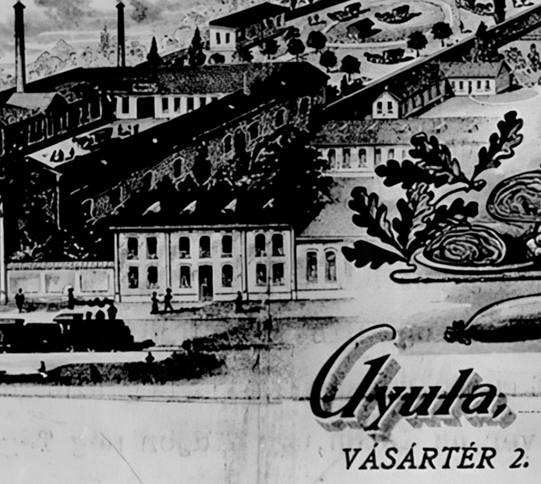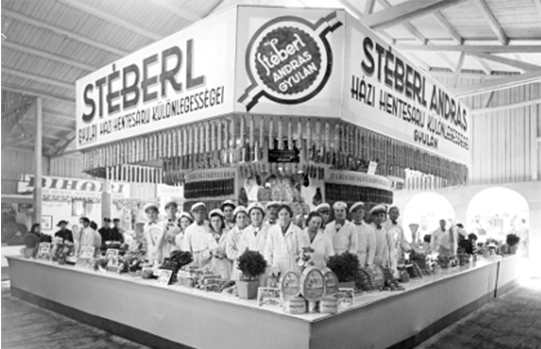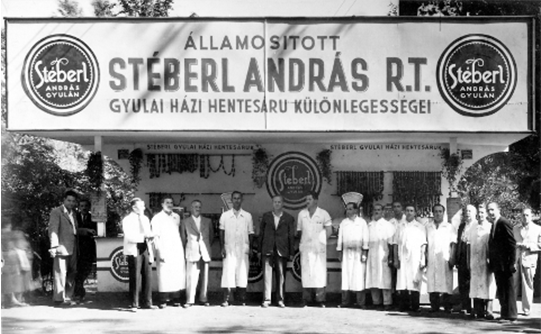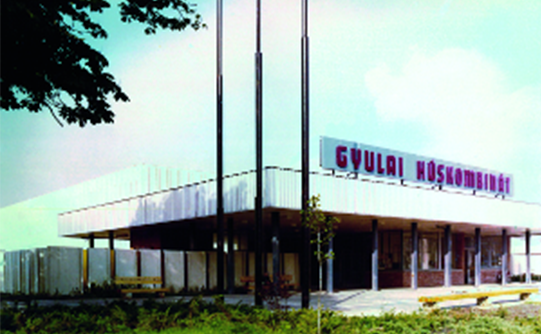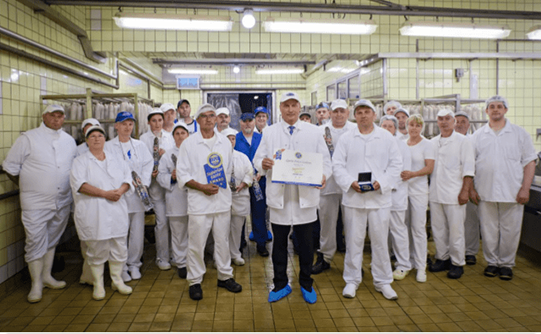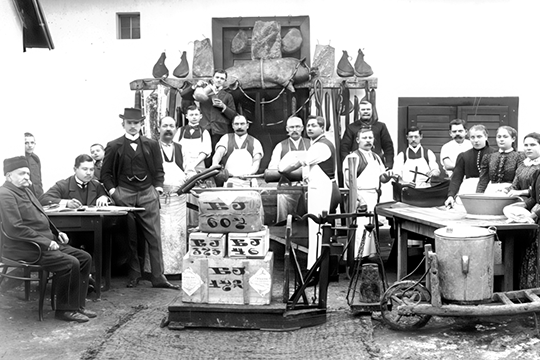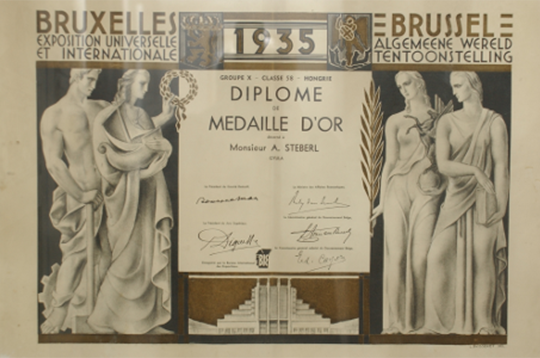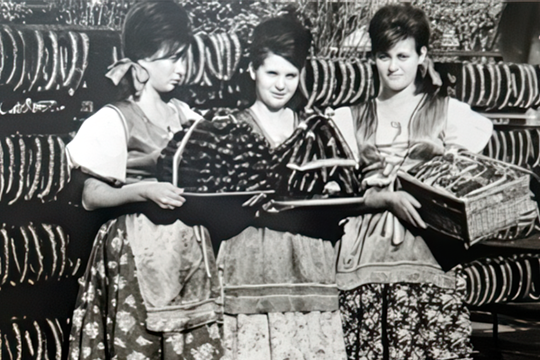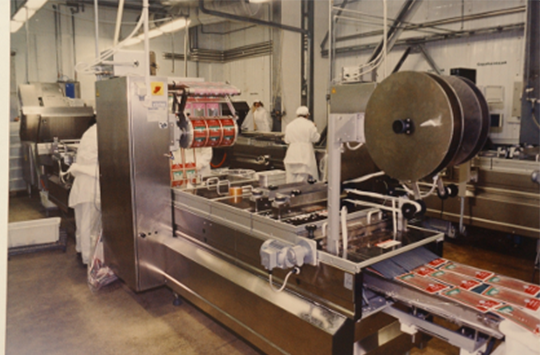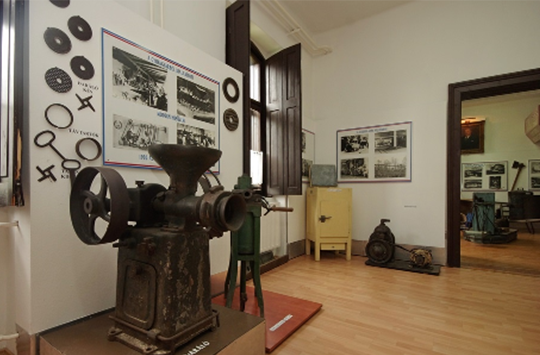About us
In the 18th and 19th centuries the Gyulai Winter Fair had rised among Europe’s most biggest fairs. These events had made the life in Gyula pretty hot, boosting the manufacturing industry.
According to some sources the pork fuss to the market had added up to 20-30 thousand porks, other sources write about – and it is a big number! – 100-120 thousand porks, that had been driven on leg to Gyula. During driving the leg of animals could have been injured, and so they must have been cut down, that their meat can be saved. This way developed a demand that a public slaughterhouse must be build up in the town, and in 1868 it had been done so.
András Stéberl worked as an assistant at jr. Balog. After he had learned the knacks of sausage producing, he connected it with the experiences gained abroad, and started the industrial production of Gyulai Sausage and other meat products. He mechanized some phases of work, which were earlier done by hand. After some years he exported the Gyulai sausage products to several continents. His financial situation allowed him to make developments, and he founded a new, modern plant with incense, cold store and depositories. Pigs bred on his feedlot were processed in a new, bigger factory from 1938. The product range had significantly expanded, which covered all segments of meat processing. Besides thin and thick sausages, winter sausage, sausage in pairs, bacon and ham there were meat and ham products, and also canned products delivered out of the factory’s warehouse.
After the nationalization of the Stéberl Meat Factory, from 1953 until three decades József Csiki was the head of the Gyulai Meat Factory, later of the Gyula Meat Company, then of the Animal Trade and Meat Company of Békés County, and finally of the Gyula Meat Combinat. It was József Csiki’s merit that the production of famous Gyula Sausage stayed in Gyula. At that time the leadership of the company thought that in the purpose of centralization it would be better to move the company to the county seat Békéscsaba, but finally this was prevented, as well as the idea of making a jam factory from the company.
In the 1980’s 2 300 people were employed by the combinat. There were approximately 11 million pigs in the country at that time, of which 1 million was bought and sold by the Gyula company. 2/3 of the goods were exported abroad, which meant financial stability and afforded serious developments. A new product, the Gyulai Liver Paste was developed, and in 1990 a cold store was built with a storing capacity of 2000 tons.
In February 2013, Gyulahús Kft. started its production of meat products placed on a new foundation. With the help of job retention state support, the local government purchased the buildings, machines and brand-name of the former meat combinat from the liquidator, thus saving the Gyulai meat industry. The production of dry products is still carried out in the original Stéberl plant with the use of traditional technologies, while production of goods like liver paste, frankfurter or cold cuts – still continues in the plant of Kétegyházi street. In both plants there is a continuous product development and it is an important aspect that the new products can be integrated into the diets of food allergy sufferers. Our mission is that 150 years later, Gyulai will still mean a symbol of quality, expertise, tradition and dedication.
In the end of 19th century the Gyulai Sausage was produced in full swing, and a lot of butchers offered their merchandise. Among them emerged jr. József Balog, who made Gyulai across Europe well-known, and won a golden metal with his sausage in 1910 at Brussels World Fair.

Fortunately the success did not stay away, and the Master won a Gold Diploma with his „small pairs of Gyulai sausage” at Brussels World’s Fair in 1935.
After socialization of Stéberl Meat Plant the sausage factory continued to operate as Gyula Meat Industry on a seasonal basis. The complex large plant, the Gyulai Meat Plant started its operation in 1978. It was firstly realized in the industry that a processing plant was installed next to a slaugherhouse. The new, modern facility made it possible to bring to the market new types of product besides dry sausages.
By the end of the 90's the entire Hungarian manufacturing industry was in a difficult position, and the company in Gyula was no exception. After the change of regime, deliveries to the eastern market were ceased and the production capacity was far greater than domestic demand. As a parallel phenomenon the number of pigs decreased, the production became more expensive, the foreign trade chains appeared and the prices of domestic producers broke. All of these resulted to the fact that the profitability of the company became unsustainable by 2012 and the Gyulai Combinate was eliminated in October.
More than 100 years old but still working slicer, icebox that weights more than 100 kilograms, quintals, trough, ringa, cutter - just a few devices to mention among the objects exhibited in the museum. Photos from the turn of the century and from the golden age of 1970’s and 80’, laboratory devices, knives, hatchets give an insight for us to the history of the past one and a half century. Full of interesting tools that can be still found on domestic pig slaughters. The building, where the museum can be found, is situated on the territory of the public slaughterhouse built in 1868 (map and more info) The professional guided tours tell interesting stories about meat industry in Gyula, to whom these three centuries can be thanked for, how the meat was processed to sausage when there were no machineries yet. The Traditions Association of Butchers of Gyula regards as a labor of love the past of „Gyulai”, commemorates our ancestors on several events and pig slaughter presentation, thus perpetuating the reputation of worthily famous Gyulai.
„What is the difference between Gyulai and Csabai Sausages?”
This question is often asked at home and abroad as well...
The first most conspicuous difference is that Gyulai Sausage is paired, filled into pig’s small intestine and 30-35 mm diameter thick at its matured state, while the Csabai is filled into pork’s intestine, which diameter is 40-50 mm, but in some cases 60 and its thickness is not even.
The other significant difference lies in seasoning. Gyulai is seasoned mainly with black pepper, the Csabai only with cumin. Both of them are paprika sausages, but Csabai is always spicy, Gyulai is slightly spicy due to black pepper.
Nowadays Csabai Sausage is manufactured by butchers and butcher dynasties, Gyulai Sausage produced on an industrical scale since the times of András Stéberl. Those who visit County of Békés, can not go home without tasting these two Hungaricums!

